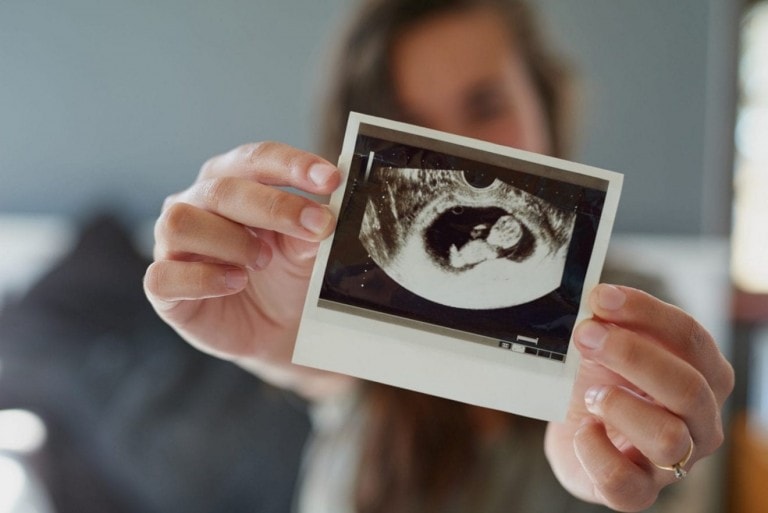Genetic testing during pregnancy is more widely available than ever. This increased access is primarily due to recommendations by OB/GYN organizations to offer non-invasive prenatal testing (NIPT) to all pregnant people.10 What can NIPT tell you about your pregnancy? What happens if your screening results show that your pregnancy is at higher risk for one of the conditions?
First, it is essential to understand the difference between screening and diagnostic tests. Screening tests provide information on the possibility of a baby having a particular condition. Screening results may be “high-risk” or “low-risk” or as a risk number (e.g., 1 in 100). A diagnostic test can confirm if a baby has a specific condition.
What conditions does NIPT screen for?
NIPT screens for trisomy 21 (Down syndrome), trisomy 18 (Edwards’ syndrome), and trisomy 13 (Patau syndrome). Typically, humans are born with 46 chromosomes that come in 23 pairs. Babies with a trisomy have three copies of a particular chromosome instead of two. In most cases, trisomies occur by chance. There is nothing parents do before or during pregnancy that causes a chromosomal trisomy.
An extra chromosome 21 causes Down syndrome, and about 1 in 600 babies is born with Down syndrome.1 Individuals with Down syndrome have intellectual disabilities that are usually in the moderate range and can also have heart defects, weak muscle tone, and can be smaller than average. Other health and learning problems can also occur in children with Down syndrome, but these problems will vary. With advances in healthcare and education, more people with Down syndrome are completing school, working, and forming meaningful relationships.6
Trisomy 18, caused by an extra copy of chromosome 18, is seen in about 1 in 3,000 babies at birth.2 Trisomy 13, caused by an extra copy of chromosome 13, is seen in about 1 in 5,000 babies at birth.3 Babies with trisomy 18 and trisomy 13 have life-threatening birth defects and severe intellectual disabilities. Many pregnancies with trisomies 18 and 13 will miscarry. Babies born with trisomy 18 and trisomy 13 usually do not live past a few days or weeks. Only 5% to 10% of babies with trisomies 18 and 13 live longer than one year.8,9
Testing for Sex Chromosomes
In addition to trisomies 21, 18, and 13, NIPT can assess a pregnancy’s risk for an abnormal number of sex chromosomes (X and Y). In general, sex chromosome abnormalities are milder in their effects on development than the other trisomies. Some of these conditions can affect puberty and fertility. Most people with a sex chromosome abnormality will have an average IQ, but many will experience learning challenges.8,9
Some, but not all, NIPTs assess a pregnancy’s risk for genetic conditions caused by microdeletions, which are small, missing parts of a chromosome. One of these conditions is the 22q11.2 deletion syndrome (DiGeorge syndrome).4
The 22q11.2 deletion syndrome is a genetic disorder caused by a missing section of chromosome 22, present from the time parents conceive a child.4 The 22q11.2 deletion is present in 1 out of every 1,000-2,000 pregnancies. Genetic deletion can affect every system in the human body with mild to severe health and developmental issues. Some individuals have many symptoms of 22q11.2 deletion syndrome, while others have almost none. Newborn diagnosis and early detection of this condition allow for interventions and therapies that can help ensure the best outcomes.
How does NIPT work?
NIPT is a prenatal genetic screening test that requires a blood draw from a pregnant person, and a medical provider can perform one as early as nine weeks gestation. During the first trimester of pregnancy, the baby develops a placenta, an organ that connects it with the pregnant person’s blood supply. The placenta releases placental DNA (cell-free DNA) fragments into the pregnant person’s bloodstream, which is usually identical to the baby’s DNA. NIPT examines cell-free DNA in the pregnant person’s blood to assess a baby’s chance of having certain genetic conditions.
What to Do if You Receive a High-Risk NIPT Result
Remember that NIPT is a screening test. A high-risk NIPT result means the chance that the pregnancy has one of the screened conditions is significantly increased. A high-risk NIPT result is not a diagnosis of the condition in the baby.
For all genetic testing during pregnancy, there is a chance of receiving a high-risk result for a pregnancy unaffected by the specific condition marked as high-risk. This type of result can sometimes be called a “false-positive result.” NIPT has a high degree of accuracy while also being highly sensitive. But still, some tests will return “false positives.” These results are more common when the condition is rare. That’s important to remember since some conditions being screened for by NIPT are rare.
Biological reasons might also lead to a “false-positive” result. There could be a chromosome difference in the placenta that is not present in the baby. Or the mother could have a chromosome condition that the test detects.
Given that NIPT is a screening test, you should make no irreversible pregnancy decisions based on the results of NIPT alone. Genetic testing during pregnancy is complex. The results are not always easy for patients to interpret on their own. Let’s review your next best steps:
1. Talk to a genetic counselor, OB-GYN, or maternal-fetal medicine specialist.
After receiving a high-risk NIPT result, your provider may refer you for genetic counseling. Genetic counselors are master’s trained, board-certified, and often licensed (state-dependent) healthcare professionals who explain genetic test results and can talk to you about your next best steps and options.
Many genetic screening companies that offer NIPT employ genetic counselors. You may be able to speak to a genetic counselor about your test result at no cost. If you don’t have access to a genetic counselor through your testing company or care provider, you can search for one through the National Society of Genetic Counselors here.
You should also speak with your OB-GYN or a maternal-fetal medicine (MFM) specialist. MFM specialists are OB-GYNs who completed additional years of training in high-risk pregnancies. MFM specialists can be an excellent resource for providing expert insight into your genetic testing results for all pregnancies. You can ask your OB-GYN for recommendations on an MFM specialist or search for one through the Society for Maternal-Fetal Medicine here.
2. Ask your care provider questions to ensure you understand your genetic test result.
What condition is high-risk? What is the chance that the baby truly has this condition? And what medical issues might affect the child if doctors confirm the diagnosis?
Your care provider can explain any statistics that appear on the test report. High-risk NIPT reports often include a positive predictive value (PPV). The PPV tells you how likely it is that someone with a high-risk NIPT result has an affected pregnancy. For example, a PPV of 95% for Down syndrome means a 19 out of 20 chance the baby has Down syndrome and a 1 out of 20 chance the baby does not.
3. Consider your options for more evaluations and diagnostic testing.
- Detailed anatomy ultrasound: A detailed ultrasound can be helpful as it looks for any physical signs you might see with the chromosomal condition of concern. However, a routine ultrasound does not mean that the baby does not have the condition.
- Prenatal diagnosis: Depending on your screening result and how far along you are in the pregnancy when you receive your results, you could be offered prenatal diagnosis by chorionic villus sampling (CVS) or amniocentesis:
- Chorionic Villus Sampling (CVS): A small amount of placental tissue is removed for chromosomal analysis. This is an outpatient procedure performed between 10-12 weeks of pregnancy. Results are usually available in 1-2 weeks. Following the CVS procedure, the risk for complications, including miscarriage, is <1%.
- Amniocentesis: A small amount of amniotic fluid is removed for chromosomal analysis. This is an outpatient procedure typically performed between 15-20 weeks of pregnancy (but your provider can perform it later). Results are usually available in 1-2 weeks. The risk for complications, including miscarriage, is <1% following the amniocentesis procedure.
- Postnatal genetic analysis: You can also have diagnostic testing after delivery.
4. Personally weigh the risks and benefits of more testing.
How concerned are you about the condition in question? Would a confirmed diagnosis prenatally change your plans for the pregnancy or its management? Can you accept the level of risk associated with CVS or amniocentesis?
A confirmed prenatal diagnosis allows expectant parents to plan the remainder of the pregnancy and consider available options. They can learn what medical problems could affect the newborn and if you might need delivery at a specialized hospital. Families can choose a pediatrician who understands the medical needs of the child. They can inform friends and family of the diagnosis. In some cases, diagnostic testing can rule out the suspected condition, reassuring expectant parents for the remainder of the pregnancy.
Doctors can treat some conditions screened for by NIPT or the associated symptoms. Treatment can drastically improve outcomes for newborns. For example, consider the 22q11.2 deletion, the most common microdeletion syndrome. The average age of diagnosis for the 22q11.2 deletion syndrome is 4.7 years, which can involve a long and sometimes stressful diagnostic odyssey for the family.11 However, prenatal diagnosis allows immediate early interventions at birth that could improve outcomes. That can include treatment for low calcium to reduce the risk of seizures, correction of heart defects, and evaluation of vaccination schedules because of immunodeficiencies associated with the 22q11.2 deletion.4
Genetic testing during pregnancy can provide valuable information. But it’s essential to understand the results, including the limitations of the results and what comes next. Healthcare providers and genetic counselors can help give you information and support to help you prepare and plan for the future.




















